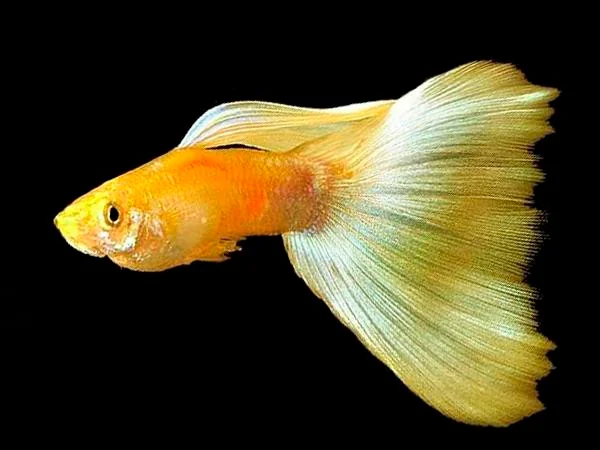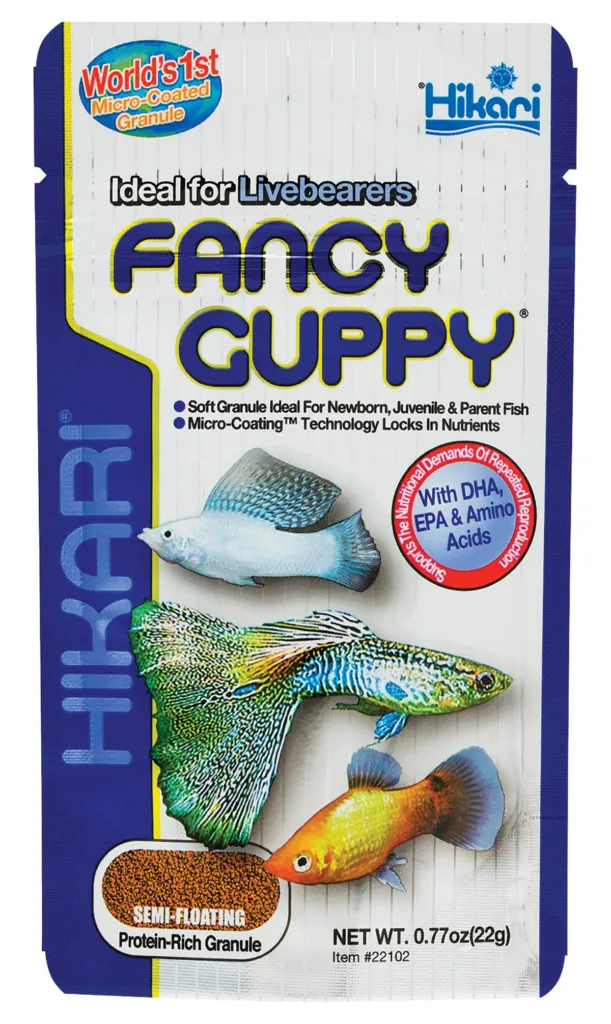Yellow Guppy is a captive bred guppy that originate from wild guppies from south america. Guppies are one of the most popular breeds of fish to keep in you freshwater aquarium and in a tropical tank they look good swimming in a school.
What is a yellow guppy?
The yellow guppy is a popular freshwater fish that is known for its bright yellow coloration. Yellow guppies are a selectively bred variety of the common guppy (Poecilia reticulata). They are native to the Caribbean and South America, but they are now found in aquariums all over the world.
Appearance
Yellow guppies are typically small fish, with males reaching about 1.5 inches in length and females reaching about 2 inches in length. Males have more vibrant coloration than females, with their yellow bodies often adorned with bright orange, red, or black spots. Females have a more subdued coloration, with their yellow bodies often being marked with gray or black spots.

origin of yellow guppies
Yellow guppies are a selectively bred variety of the common guppy (Poecilia reticulata), which is native to the Caribbean and South America. The wild guppy is a plain fish and bears no comparison to cultivated forms of today. Wild guppies have been introduced to many parts of the world to try and control mosquitoes as they love eating the larvae and they are prolific breeders.
The exact origin of the yellow guppy is unknown, but it is thought to have been developed in Europe in the early 1900s. Yellow guppies were first introduced to the United States in the 1930s, and they quickly became one of the most popular aquarium fish in the country.
Yellow guppies are now bred all over the world, and there are many different color strains available. Some of the most popular color strains of yellow guppies include:
- Lemon guppies
- Gold guppies
- Orange guppies
- Pineapple guppies
- Sunset guppies
No matter what color strain you choose, yellow guppies are sure to add a touch of beauty to your aquarium
Tank setup
Tank size
Yellow guppies are relatively small fish, but they are active swimmers, so they need a tank that is large enough to provide them with plenty of space to swim around. A 10-gallon tank is a good minimum size for a group of six yellow guppies.
Water parameters
Yellow guppies prefer warm water with a temperature range of 72-82 degrees Fahrenheit. They also prefer hard water with a pH of 7.0-8.5. It is important to test your water regularly to make sure that the parameters are within the ideal range for your yellow guppies.
Filtration
Yellow guppies require a good filtration system to keep their water clean and healthy. A hang-on-back filter or canister filter is a good option for a 10-gallon tank.
Decorations
Yellow guppies appreciate having plenty of hiding places in their tank. You can provide them with hiding places by adding plants, rocks, and other decorations to the tank.
Tank Mates
- Pink Tuxedo Guppy
- Fantail Guppy
- Green Guppy
- Tequila Sunrise
- Blue Tarzan Guppy
- Santa Claus Guppy
- Blue Moscow Guppy
- Salt and Pepper Catfish
- The Bronze Cory Catfish
- Ember Tetra
- Cardinal Tetra
Breeding
Sexing yellow guppies
Male yellow guppies are typically smaller and more slender than female yellow guppies. They also have a brighter coloration and a longer anal fin. Female yellow guppies are typically larger and more rounded than male yellow guppies. They also have a shorter anal fin and a gravid spot, which is a dark spot on the abdomen that indicates that the female is pregnant.
Breeding yellow guppies
Yellow guppies are relatively easy to breed in captivity. To breed yellow guppies, you will need a male and female guppy. You can place the male and female in the same tank, and they will breed naturally.
Once the female is pregnant, she will give birth to live fry. The fry are very small and need to be fed a specialized fry food. The fry will grow quickly and will be ready to be moved to their own tank in a few weeks.
Feeding
Yellow guppies are omnivores, so they will eat a variety of foods. You can feed them a high-quality flake food, pellets, or live food. It is important to feed your yellow guppies a variety of foods to ensure that they are getting all of the nutrients they need.

Diseases
Yellow guppies are susceptible to a number of diseases, including ich, fin rot, and white spot disease. It is important to inspect your yellow guppies regularly for signs of disease. If you notice any signs of disease, you should treat the fish immediately.
Common yellow guppy diseases
- Ich: Ich is a common parasite that causes white spots to appear on the fish’s body and fins. Ich is treated with medication or by raising the temperature of the tank.
- Fin rot: Fin rot is a bacterial infection that causes the fish’s fins to rot away. Fin rot is treated with medication or by cleaning the tank and removing any debris.
- White spot disease: White spot disease is a parasitic infection that causes white spots to appear on the fish’s body and fins. White spot disease is treated with medication or by raising the temperature of the tank.
Uncommon and expert advice
- Use a black background for your tank. This will help to make the yellow guppies stand out more.
- Feed your yellow guppies live food occasionally. Live food, such as brine shrimp and bloodworms, is a good source of protein for yellow guppies.
- Breed your yellow guppies to create your own unique color strains. Yellow guppies are relatively easy to breed, so you can experiment with different breeding pairs to create your own unique color strains.
Where to buy yellow guppies?
There are many places where you can buy yellow guppies. Here are a few options:
- Local pet stores: Most local pet stores like petco sell yellow guppies. However, the selection may vary depending on the store.
- Online retailers: There are many online retailers that sell yellow guppies. You can find a wider selection of yellow guppies online than you would typically find at a local pet store.
- Breeders: You can also buy yellow guppies from breeders. This is a good option if you are looking for a specific color strain or if you want to support small businesses.
When choosing a place to buy yellow guppies, it is important to do your research. Make sure to read reviews of the different places you are considering buying from. You should also ask about the health of the fish and the store’s return policy.
Here are a few tips for buying yellow guppies:
- Inspect the fish carefully before you buy them. Look for any signs of disease or injury.
- Ask the seller about the fish’s diet and care requirements. Make sure that you can provide the fish with the care it needs.
- Buy the fish from a reputable seller. This will help to ensure that the fish is healthy and that you are getting a good quality fish.
Once you have purchased your yellow guppies, be sure to quarantine them for two weeks before adding them to your main aquarium. This will help to prevent the spread of any diseases.
How Much Do Yellow Guppies Cost?
The price of yellow guppies can vary depending on a number of factors, including the color strain, the size of the fish, and the seller. However, in general, yellow guppies are relatively inexpensive fish.
You can typically expect to pay between $1 and $5 per yellow guppy at a local pet store. Online retailers and breeders may charge more or less depending on the fish they are selling.
If you are looking for a specific color strain or a larger fish, you may need to pay more. For example, a rare color strain of yellow guppy may cost $10 or more.
Here are a few tips for finding the best price on yellow guppies:
- Shop around and compare prices from different sellers.
- Look for discounts and sales.
- Buy in bulk if you are planning on getting a lot of yellow guppies.
- Consider buying from a breeder. Breeders often have lower prices than pet stores and online retailers.
Keep in mind that the cost of purchasing yellow guppies is just the beginning. You will also need to budget for the cost of an aquarium, filtration system, food, and other supplies.










